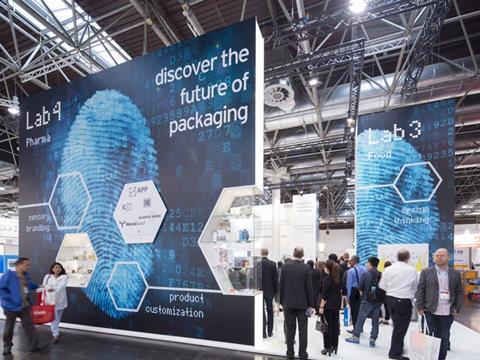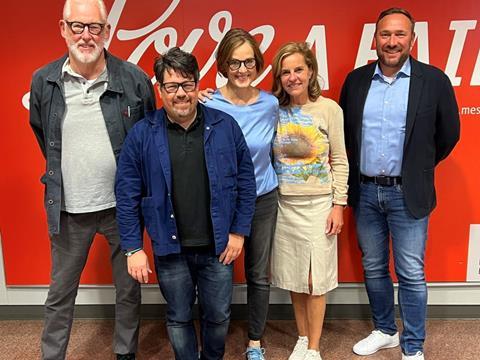The world of packaging is dynamic and fast-paced, and packaging printing is no exception. Ahead of drupa 2024, Elisabeth Skoda takes a closer look at the touchpoint packaging event series and explores industry megatrends.

Packaging Europe is excited to support touchpoint packaging as a content and media partner. In its third iteration, the event series, taking place from May 28th to June 7th, 2024, will offer drupa visitors a dynamic platform which will zoom in on a range of topics around packaging printing and will focus on environmental, technological, economic, social and legal aspects. The event will pinpoint challenges, present innovative solutions and showcase added value, impulses and growth potential for packaging solutions in a constantly changing world.
Visitors, in particular brand owners, will be able to attend presentations that feature best practice examples and innovative packaging design, and that give an overview of the latest developments in design and production and gain useful insights. There will be no charge for the event.
Packaging experts from across the value chain, from material sourcing to production and workflow to converting and retail will take part as partners or active participants. Participants include major drupa exhibitors such as esko, Koenig & Bauer, Heidelberg, hp, Zecher, hubergroup, KURZ, manroland Goss and Saueressig.
drupa continues its successful partnership with the European brand and packaging design agency edpa, which will be responsible for the concept and the running of the event. Marketing intelligence agency Mintel will support the event with specialist knowledge.
Furthermore, all members of the packaging printing value chain are invited to become exhibiting partners, whether it’s brands, material suppliers, converters or embellishment experts. Find out more at www.drupa.com.
Ahead of the event, we asked key stakeholders about what visitors can expect from the touchpoint packaging event and what key industry trends they have observed.
What can visitors expect to see at touchpoint packaging?

epda Vice-President Uwe Melichar: We want to discuss topics ‘Beyond machines and materials’. It’s important to involve all stakeholders of the value chain and to take a holistic look at things, including the design perspective, we believe. We will focus on use case scenarios and inspire with future-oriented product and packaging solutions.
What are the key trends that will be addressed at the event?
Claudia Josephs, epda General Manager: Our objective is to show visitors how new technologies in print and packaging can meet the needs of the end-consumer and inspire brand owners when developing new products and packaging. For that purpose, we have defined five key topical areas reflecting the main overall trends. These topics will be leading exhibition contents as well as the all-day conference programme: Neo-ecology, glocalisation, taxes &andregulations, connectivity and the consumer’s mind and behaviour.
What major trends and developments have you observed in the packaging industry since the last drupa?
Dr. Andreas Pleßke, Vorstandssprecher Koenig & Bauer: Today, packaging has considerably more functionality. It’s not only about protection, transport, shelf life or the marketing message at the point of sale. The next phase has started, and traceability, authenticity and augmented reality solutions that offer added value to customers are in high demand. Packaging is becoming interactive. On top of that, brand owners and their customers demand sustainable packaging.
Christian Menegon, Business Development Manager Industrial products at HP:
A very visible newcomer amongst the trends is sustainability. This word is too generic to define measurable and comparable targets and is therefore hard to quantify. For instance, an ink manufacturer will use fewer chemicals to be more sustainable; a substrate supplier will put biodegradable paper on the market; a machine manufacturer will use more energy-efficient motors; a brand owner will reduce its inventory and therefore produce less waste; at home, I have replaced all halogen lamps at home with LEDs, etc… All of these actions are important but which one counts more than the others?
While comparison is not necessarily possible and maybe even not needed, it is good that industry players are innovating to save the planet; this leads to the implementation of changes, process innovations, workflow improvements etc. It is fair to say that cooperation between actors of the value chain will bring even better results. In the past any improvement was geared more towards better specs, performance and cost reduction; nowadays the new eco-system brings different targets. Efficiency, waste reduction and circularity can be seen as the ‘headlines’ for whatever internal development plan a given company acts on, with many diverse sub-levels.
Jan De Roeck, Esko Director of Marketing, Industry Relations & Strategy
Given that 2020 saw the need for drupa to go virtual due to the global pandemic, the last physical event was in 2016 – seven years ago, which really is an eternity in terms of technological evolution. With that in mind, the main trends I have observed since are the ongoing acceleration of digital transformation and the ever-growing impact of environmental sustainability.
Taking a bit of a higher vantage point to look at these two megatrends, I really believe the end-user of packaging, i.e. the consumer, is impacting both of these megatrends. The macro-economic and societal megatrends that are happening around us – which include supply chain issues, inflation, a pandemic, online shopping, consumer trends, the war in Ukraine, political polarization, and many more - have a profound impact on how and what consumers buy. As a consequence, brands and retailers accelerate the speed at which they respond to these changing consumer needs.
New products and product categories arise, and multiple variants of existing products are launched in an attempt to satisfy the fast-changing moods of consumers. The packaging and label supply chain needs to follow.
Pressure on lead times is the most frequently heard business challenge, with quality now being the expected absolute minimum, table stakes if you will, and cost pressure never having left the scene. Given that, there is only one way forward for packaging and label converters: to seek operational excellence and continuous elimination of waste and cost out of the production process.
And the environmental sustainability debate fundamentally also starts with the consumer. A profound desire to safeguard our planet for generations to come is an underlying societal trend with a profound impact on packaging. Reduction, recycling and re-use of packaging may well be a substrate-centric discussion in the first place, but every step in the process from concept to shelf can contribute to waste reduction. This way sustainability and operational efficiency are tightly connected.












No comments yet